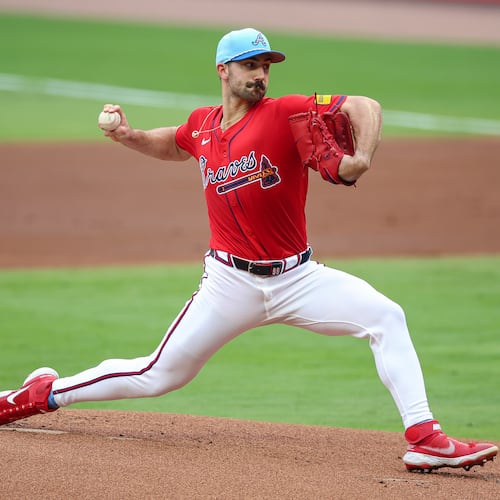When Sean Rodriguez, the utility man slotted for heavy duty at second base, was injured in a winter car crash, the Braves’ solution wasn’t to dip into their top-rated farm system but to work a pennies-on-the-dollar trade for Brandon Phillips, who’s 35. When franchise cornerstone Freddie Freeman was lost for 10 weeks to a broken wrist, they moved to deal a middling prospect to St. Louis for Matt Adams, once a World Series starter but lately a Redbirds backup.
These moves came after a December that saw the Braves sign Bartolo Colon and R.A. Dickey as free agents and trade for Jaime Garcia. Aggregate numbers on those three starting pitchers: One year of work at $32.5 million for arms of 115 years’ vintage. And this, we note, from a club supposedly banking everything on young pitching.
About here, you might be asking: Isn’t depth the second-biggest reason for having a farm system? So why, when need arises, is the Braves’ first look to go outside and old? (You’ll recall that the Braves also gave a Gwinnett audition to Ryan Howard, the 37-year-old who the Phillies bought out for $10 million.) Is this a sign that the much-ballyhooed rebuild is in trouble?
Short answer: No.
Longer answer: The biggest reason to have a farm system is to develop young players. As tempting as it might have been to bump up Ozzie Albies when Rodriguez was hurt, the reality is that he’s 20. He was the youngest player in Triple-A last season, and he hasn’t yet handled Triple-A pitching the way he did the Double-A Southern League. The John Hart/John Coppolella administration has been in place only 2 1/2 years. In the grand scheme, their redo is indeed, as Hart said last fall, ahead of schedule. Nobody, however, outruns the calendar.
The incongruity of the Braves’ rebuild is that the product most folks see doesn’t look like it’s rebuilding. Its big-league everyday eight includes five players on the high side of 30. Its closer is 33. Its youngest starting pitcher is Mike Foltynewicz, who’ll turn 26 in December. (The Braves’ best pitchers in the worst-to-first postseason of 1991 were John Smoltz, 24, and Steve Avery, 21.) The major-league team is the kind that, in most cases, you’d rather not have — a low-ceiling aggregation with lots of age. This is the one case where it makes some semblance of sense.
Building around youth is prudent: Younger players cost (much) less. A team gets to pick its younger players, as opposed to buying somebody else’s free agent. If we’ve learned anything in these 2 1/2 years, it’s that rushing youth doesn’t work. Coppolella, who’s Catholic, essentially offers a mea culpa every time he mentions the examples of Matt Wisler and Aaron Blair struggling in the majors last season. But the alternative to waiting for youth to flower is usually losing 100 big-league games. The Astros did it. The Cubs did it. The Padres are about to do it.
The Braves of Coppolella and Hart haven’t done it yet and probably won’t. This team hasn’t been as good as was hoped, but it awoke Monday with the second-best record in the admittedly wretched National League East. This is because the Braves haven’t yet Thrown The Kids Out There en masse. That will happen someday — Coppolella envisions “wave upon wave” of prospects — but the organization keeps trying to do its toe-dance between not quite competing while not outright stinking.
And it’s working, sort of. It’s unreasonable to expect these Braves to go on a tear without Freeman, though the schedule — 35 of the next 41 games are against opponents at/below .500 — isn’t oppressive. A batting order with Matt Kemp, Nick Markakis, Ender Inciate, Tyler Flowers, Dansby Swanson and Adams won’t scare the Cubs or the Nationals, but it trumps what the Mets and Phillies and Padres have.
If your goal is enduring mediocrity, you’re in the wrong business. Coppolella’s stated aim is to contend for a championship on an annual basis. (You know, the way the Braves once did.) If mediocrity is merely a bridge, it can have merit. Trading for Adams and Phillips — and signing Colon and Dickey — weren’t moves designed to make the Braves great again. They were intended to fill immediate needs and, above all, to buy time.
It will be intriguing to see what would happen if the Braves hit the All-Star break within, say, four games of the second wild card — they were six back Monday — with Freeman set to return. The belief has long been that this year’s holding action would hold only until the July 31 trade deadline, at which time Coppolella would sell Colon/Dickey/Garcia/Phillips to contenders for more precious prospects. But what if this season looks like it might reward mediocrity? Would the Braves actually try to buy?
Short answer: No. Too soon. Maybe next year, though.
About the Author
Keep Reading
The Latest
Featured



